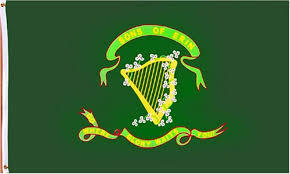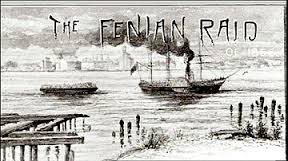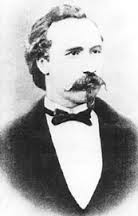
June 2, 1866
This blog is intended to be a companion to the published sources on the Fenian Raid of June 1 & 2 1866, and the Battle of Ridgeway and Fort Erie. Primarily anecdotal. it focuses on persons and incidents that were part of the incursion. Sources available on request. All images public domain.
They Cheered On Landing
On the afternoon of May 31, 1866 Thomas L. Newbigging, the second son of a Scottish immigrant farmer, was told by a Fort Erie Customs House officer that the Fenians were coming over.
Later that evening he retired to bed but soon afterward got back up, dressed, and walked down to the River Road. "The evening was calm" he relates, "the wind blowing up from the dock towards our house. When I got to the road I could see steam escaping from two tugs, and I heard the wheels of wagons coming on to the dock on the American side." The moon was brilliant. three days past full. It lit up the entire shore.
"Just before daylight" he continues, "the two boats starting (pulling) two (canal) boats, each filled with armed men. They steamed to the Canadian shore, and as they approached they shut off steam as if hesitating where to go. Then they started up the river to the Shingle Dock or Lower ferry nearly opposite Pratt's Dock (Pratt's Blast Furnace dock at Black Rock), and there they landed."
Another Fort Erie resident, Arthur Molesworth, an engineer, was on the road as well, and saw the Fenians when they arrived between 3 and 4 o'clock AM at the Lower Ferry docks known as Freebury's Wharf. "They cheered on landing." he relates.
The 17th Kentucky Fenian Regiment under Col George Owen Starr had already reached the shore two hours earlier. This small expeditionary unit had commandeered a steam tug and a large Canadian timber scow which had been unloading in Buffalo. They crossed the Niagara River ahead of the main force to the Lower Ferry around 1:30 AM. The colour bearers leaped ten paces from the boat, scrambled up the banks of the river, and planted three Irish flags in Canadian soil.
Starr left a small force to secure the dock and then continued down Niagara Road to Old Fort Erie where he took a few British soldiers captive and then burned Sauerwein's Bridge (near Centralia and The Friendship Trail) thereby cutting off any rail approach from Port Colborne of Ridgeway.
The men of the main company were given supplies from nine wagons of arms and ammunition. About 8 o'clock AM they began to march with fife and drum, toward Fort Erie. "The men who were marching had rifles and bayonet, about fifteen hundred, marching four abreast" Molesworth observed.
In 1866 Fort Erie, or Waterloo as it was known then, was a village of 750 people with three churches, a schoolhouse, some hotels, boarding houses, stores and a few brick homes with orchards and tree groves. At the western end of Waterloo, a mile southwest of the village itself, were wharves, warehouses, the Lewis House hotel, a custom house and a group of clapboard houses. Two miles further on, directly across the river from Buffalo lay a clutch of houses and the remains of Fort Erie from the War of 1812.
The Fenians marched toward the village on the river road, past St. Paul's Church and stopped at the house of the reeve, Dr. Peter Tertius Kempson, a British-born physician. The Fenian leader, Colonel John O'Neill, did not mince words. "I require that you assemble the principal inhabitants and, without delay, provide breakfast and rations for one thousand men." He intimated that if the inhabitants did not comply their houses would be entered forcibly, and possibly burned. The villages food supply was quickly exhausted: ham, bread, wine, brandy, coffee and tea gone in an hour. The Fenians overran the Kempson house, the hotel and the surrounding orchards and fields.
A contemporary account describes the end of the 'big breakfast'.
"When the invaders had filled themselves, and drank all the liquor in the village, they still demanded more. One hundred and fifty or two hundred continued about that hotel, singing and dancing, several hours. At last O'Neill and other officers with drawn swords came, supported by armed pickets and drove them away using such reproaches as 'you blackguards! Do you think we brought you to Canada to get drunk, and make sport? You came here to fight. The army of red coats will soon be on you."
O'Neill left a guard detail at the railway terminus, a mile south village, cut the telegraph lines, and posted pickets at the junctions of the roads and at the ferry. A proclamation was read stating that the Fenians' fight was with the British Crown, not the Canadians. However, no resident of the village could move about without having a pass.
He marched the main force back to Newbigging's farm, a mile below the spot where they landed, and set up camp around 11 o'clock.
And so began an intense two days of nation building. The Canadian identity, which up to that point had been a mix of conflicted loyalties, imperial domination and economic dependencies, became forged in the crucible of combat and self preservation, culminating in the battles at Ridgeway and the Fort Erie Dock on June 2nd 1866 the day that made Canada truly Canadian.
This blog is intended to be a companion to the published sources on the Fenian Raid of June 1 & 2 1866, and the Battle of Ridgeway and Fort Erie. Primarily anecdotal. it focuses on persons and incidents that were part of the incursion. Sources available on request. All images public domain.
They Cheered On Landing
On the afternoon of May 31, 1866 Thomas L. Newbigging, the second son of a Scottish immigrant farmer, was told by a Fort Erie Customs House officer that the Fenians were coming over.
Later that evening he retired to bed but soon afterward got back up, dressed, and walked down to the River Road. "The evening was calm" he relates, "the wind blowing up from the dock towards our house. When I got to the road I could see steam escaping from two tugs, and I heard the wheels of wagons coming on to the dock on the American side." The moon was brilliant. three days past full. It lit up the entire shore.
"Just before daylight" he continues, "the two boats starting (pulling) two (canal) boats, each filled with armed men. They steamed to the Canadian shore, and as they approached they shut off steam as if hesitating where to go. Then they started up the river to the Shingle Dock or Lower ferry nearly opposite Pratt's Dock (Pratt's Blast Furnace dock at Black Rock), and there they landed."
Another Fort Erie resident, Arthur Molesworth, an engineer, was on the road as well, and saw the Fenians when they arrived between 3 and 4 o'clock AM at the Lower Ferry docks known as Freebury's Wharf. "They cheered on landing." he relates.
The 17th Kentucky Fenian Regiment under Col George Owen Starr had already reached the shore two hours earlier. This small expeditionary unit had commandeered a steam tug and a large Canadian timber scow which had been unloading in Buffalo. They crossed the Niagara River ahead of the main force to the Lower Ferry around 1:30 AM. The colour bearers leaped ten paces from the boat, scrambled up the banks of the river, and planted three Irish flags in Canadian soil.
Starr left a small force to secure the dock and then continued down Niagara Road to Old Fort Erie where he took a few British soldiers captive and then burned Sauerwein's Bridge (near Centralia and The Friendship Trail) thereby cutting off any rail approach from Port Colborne of Ridgeway.
The men of the main company were given supplies from nine wagons of arms and ammunition. About 8 o'clock AM they began to march with fife and drum, toward Fort Erie. "The men who were marching had rifles and bayonet, about fifteen hundred, marching four abreast" Molesworth observed.
In 1866 Fort Erie, or Waterloo as it was known then, was a village of 750 people with three churches, a schoolhouse, some hotels, boarding houses, stores and a few brick homes with orchards and tree groves. At the western end of Waterloo, a mile southwest of the village itself, were wharves, warehouses, the Lewis House hotel, a custom house and a group of clapboard houses. Two miles further on, directly across the river from Buffalo lay a clutch of houses and the remains of Fort Erie from the War of 1812.
The Fenians marched toward the village on the river road, past St. Paul's Church and stopped at the house of the reeve, Dr. Peter Tertius Kempson, a British-born physician. The Fenian leader, Colonel John O'Neill, did not mince words. "I require that you assemble the principal inhabitants and, without delay, provide breakfast and rations for one thousand men." He intimated that if the inhabitants did not comply their houses would be entered forcibly, and possibly burned. The villages food supply was quickly exhausted: ham, bread, wine, brandy, coffee and tea gone in an hour. The Fenians overran the Kempson house, the hotel and the surrounding orchards and fields.
A contemporary account describes the end of the 'big breakfast'.
"When the invaders had filled themselves, and drank all the liquor in the village, they still demanded more. One hundred and fifty or two hundred continued about that hotel, singing and dancing, several hours. At last O'Neill and other officers with drawn swords came, supported by armed pickets and drove them away using such reproaches as 'you blackguards! Do you think we brought you to Canada to get drunk, and make sport? You came here to fight. The army of red coats will soon be on you."
O'Neill left a guard detail at the railway terminus, a mile south village, cut the telegraph lines, and posted pickets at the junctions of the roads and at the ferry. A proclamation was read stating that the Fenians' fight was with the British Crown, not the Canadians. However, no resident of the village could move about without having a pass.
He marched the main force back to Newbigging's farm, a mile below the spot where they landed, and set up camp around 11 o'clock.
And so began an intense two days of nation building. The Canadian identity, which up to that point had been a mix of conflicted loyalties, imperial domination and economic dependencies, became forged in the crucible of combat and self preservation, culminating in the battles at Ridgeway and the Fort Erie Dock on June 2nd 1866 the day that made Canada truly Canadian.


 RSS Feed
RSS Feed